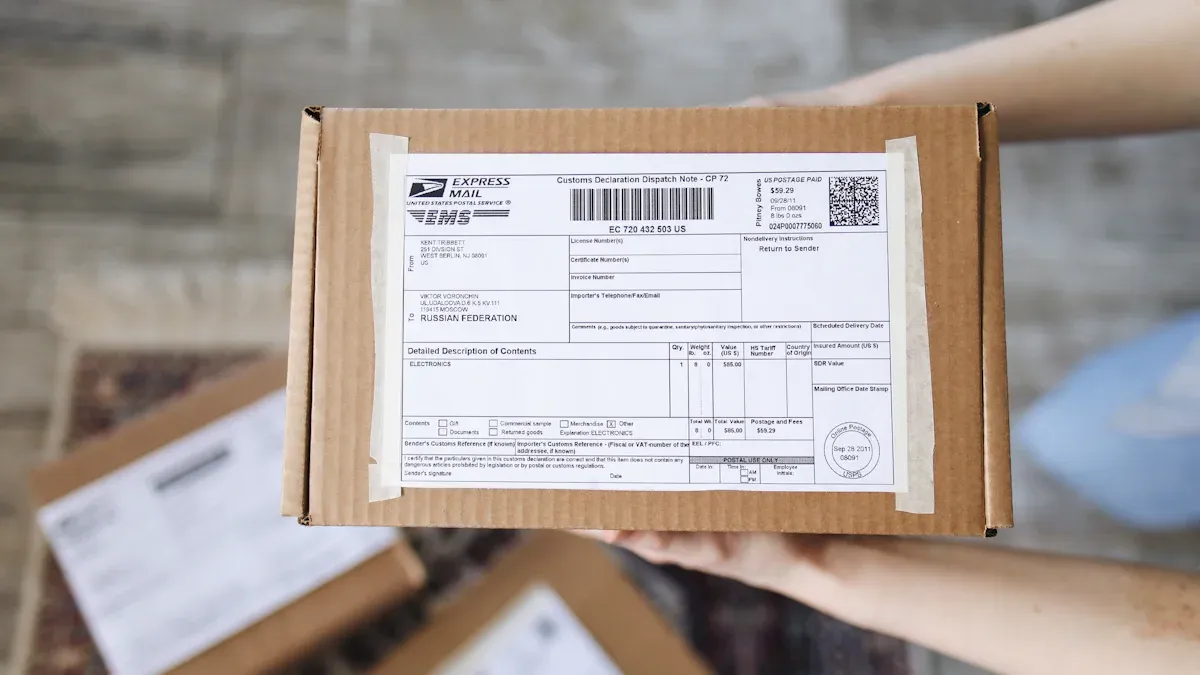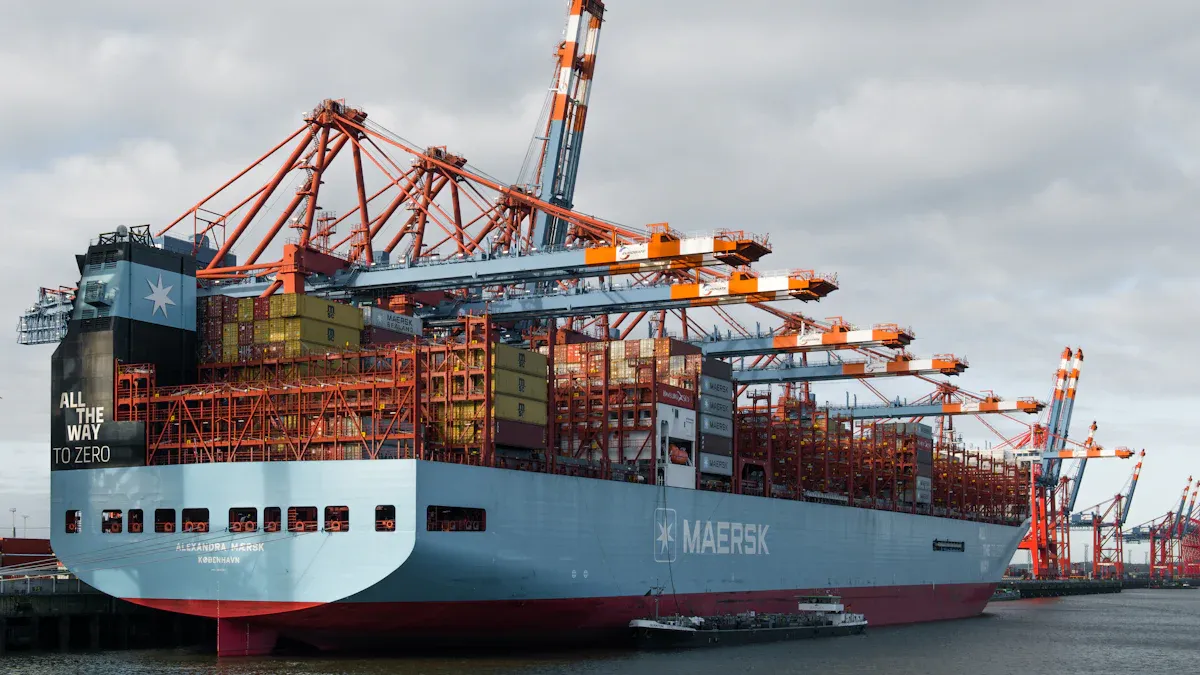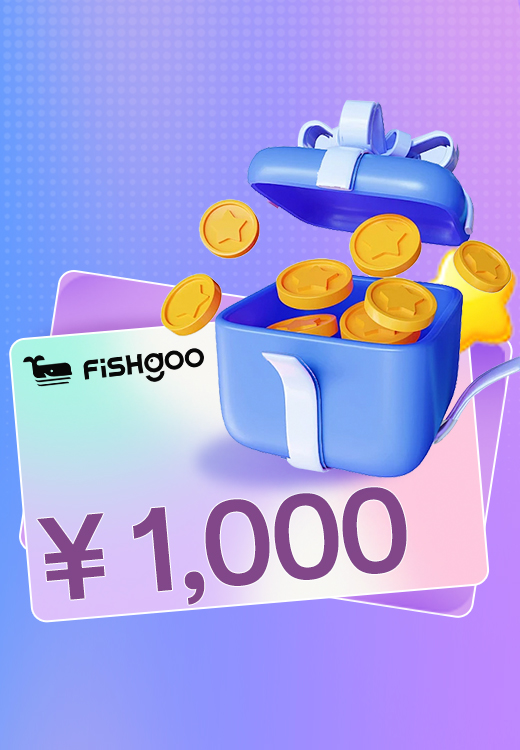Demystifying Customs: A Buyer's Guide to Clearing Parcels in the EU

You want your parcel to arrive fast and stress-free. That is where a buyer's guide comes in handy. Clearing parcels through eu customs may seem tricky, but you can handle it with the right steps. Customs clearance can feel confusing for many shoppers, especially if you have never imported goods into the eu before. Fishgoo offers a simple way to manage the process, making your buyer's guide to import smoother and worry-free.
Key Takeaways
Learn about the customs process by reading EU rules. Get all the needed documents ready. This helps you avoid waiting and makes things go smoothly.
Always check your customs papers, like invoices and packing lists. Correct documents stop delays and extra fees.
Sign up for an EORI number before you import goods. You need this number for customs clearance. It makes the process easier.
Think about hiring a customs agent or using Fishgoo for tricky shipments. Their help saves you time and lowers mistakes.
Keep up with new customs rules and changes. Knowing the latest rules helps you avoid problems and follow the law.
Buyer's Guide to EU Customs
Customs Process Overview
Customs in the EU can seem hard at first. But you can make it simple by following easy steps. If you use a guide, importing goods is not so tough. Here is what you need to do for customs clearance:
Check if your goods follow all EU and country rules. This keeps you from having trouble with customs.
Find out what duties and taxes you must pay. This includes VAT and anti-dumping duties.
Get all the papers you need, like certificates and licenses. Then send them in.
List every item you import, even if it is cheap. The EU changed its rules in 2021, so now you must declare everything.
Use the right commodity codes for your country. Add the HS code for each product too.
Look over your information to make sure it is correct. Mistakes can slow down your parcel.
Tip: Fishgoo can help you with customs. You can shop, ship, and handle customs in one place. Fishgoo helps with paperwork, declarations, and paying duties. This way, you do not miss any steps.
If you use Import One Stop Shop (IOSS), paying VAT for parcels under €150 is easier. This system makes things faster and helps you follow EU customs rules.
Who Handles Customs?
When your parcel gets to the EU, you may wonder who does the customs work. Most of the time, a customs agent takes care of it for you. Here is what they do:
They act for you or the seller and talk to customs officers.
They tell you what is happening with your parcel.
They pay duties and taxes for you, so things go smoothly.
If you use Fishgoo, experts help you with customs. You do not have to worry about hard forms or missing papers. Fishgoo helps you at every step, so importing is easy for you.
Customs Clearance Documents

When you want to bring goods into the EU, you need to get your customs clearance documents ready. These papers help customs officers check your shipment and make sure you follow the rules. If you forget a document or fill it out wrong, your parcel could be delayed. Let’s look at the main documents you need for customs clearance.
Invoice and Packing List
You must have an invoice and a packing list for customs clearance. These documents tell customs what you are sending and how much it is worth. They also help you show the value and details of your goods.
Your invoice should have these things:
The name and address of the supplier or manufacturer.
The name and address of the buyer, showing if you are the importer.
The name and address of the person getting the goods.
The country where the shipment started.
The number of each product type.
A clear description of every item and what it is used for.
The value per unit, in US dollars and the supplier’s currency.
The packing list is just as important. It helps customs see what is inside each box. Make sure your packing list has:
A correct list of what is in each package.
Descriptions of items, number of packages, volume, and weights.
Package markings and links to the commercial invoice.
Tip: Check your invoice and packing list before you send them. Mistakes can slow down your customs clearance.
Waybill and Declarations
The waybill and customs declarations are important documents. The waybill is a contract between you and the shipping company. It shows the route, charges, and details about your shipment. If you use airfreight, the waybill is even more important.
Customs declarations are needed for every shipment, even if your goods are not expensive. You must use the right commodity codes and HS codes for your products. This helps customs know what you are importing and how much tax or duty you need to pay.
Here is a quick look at the main customs clearance documents you may need for the EU:
Document Name | Purpose |
|---|---|
Commercial Invoice | Shows value and details of goods |
Packing List | Lists contents, weights, and package details |
Waybill | Contract with carrier, shows shipment route and fees |
Customs Declaration | Declares goods, includes codes for tax and duty |
Summary Declaration | Entry summary for customs |
Single Administrative Document | Main import/export form in the EU |
Import/Export Licenses | Needed for restricted goods |
Customs Value Declaration | Proves value for customs |
Freight Documents | Shows shipping details |
Note: If you use a step-by-step guide or a platform like Fishgoo, you can make sure all your customs clearance documents are correct and complete. This makes importing goods into the EU much easier.
Getting your documents right is the first step to easy customs clearance. When you prepare your customs clearance documents early, you avoid delays and extra costs. Always keep copies of your paperwork, and check for any changes in eu customs declarations.
Import Steps in the EU

Document Submission
You want your parcel to move through customs without any trouble. The first thing you need to do is submit the right documents. This step is important for every import into the EU. If you get it right, your goods clear customs faster and you avoid extra costs.
Here’s a simple table that shows how the document submission process works:
Step | Description |
|---|---|
Who makes a customs declaration? | You, your representative, or anyone who controls the goods. Usually, this person is in the EU. |
Where to submit the declaration? | At the customs office in the country where your goods enter the EU. |
How to make a customs declaration? | Online (most common), sometimes orally, or by using special channels like a green sticker. |
You usually submit your customs declaration online. This is the fastest way and helps you track your parcel. Sometimes, you can declare goods orally or use a green channel, but this only works for special cases. Most buyers use the online system because it is simple and clear.
Tip: Double-check your documents before you send them. Make sure your invoice, packing list, and waybill match the details in your customs declaration. Mistakes can slow down the customs clearance process.
If you use a step-by-step guide or a service like Fishgoo, you get help with every part of the process. Fishgoo checks your documents and submits them for you, so you do not miss anything.
Registration and EORI
Before you can import goods into the EU, you need an EORI number. This number is your key to the customs system. Without it, you cannot finish your import customs clearance.
Let’s break down what an EORI number is and why you need it:
Aspect | Details |
|---|---|
Definition | EORI stands for Economic Operators Registration and Identification. |
Requirement | You must have it to import or export goods in the EU. |
Importance | It prevents delays, helps you understand customs, and gives you special permissions if needed. |
Customs authorities assign the EORI number when you register.
You need it for all contact with customs, including applications and declarations.
The EORI number makes the customs clearance process smoother and faster.
Getting your EORI number is easy if you follow a step-by-step guide. Here’s how you do it:
Go to the customs website for the EU country where your goods will arrive.
Register for an account.
Fill out the EORI application form. You can do this as an individual or a business.
Upload your documents. You need a passport or ID if you are a person, or a business registration if you are a company.
Wait for your EORI number. You usually get it by email or in your account within a few days.
Once you have your EORI number, you can start importing goods. This number helps you with every step, from document submission to paying duties. It also keeps your import process organized and helps you avoid delays.
If you use Fishgoo, you get support with EORI registration and customs clearance. The platform guides you through each step, so you do not have to worry about missing anything.
Note: Always keep your EORI number safe. You will need it every time you import goods into the EU.
Now you know how to submit your documents and register for an EORI number. These steps are the foundation of a smooth import experience in the EU.
Duties, Taxes, and Costs
Calculating Import Fees
When your parcel arrives in the EU, you need to know how much you will pay for customs duties and taxes. These fees depend on a few main things. Customs officers look at the value of your goods, the country where they come from, and the type of product you are importing. Here is a simple table to help you see what matters:
Factor | Description |
|---|---|
Value of the goods | The price you paid for the items. |
Customs tariff | The tax rate set for your product type. |
Origin of the goods | The country where your items were made. |
Customs duties are fees that governments charge on imported products. They help protect local businesses and bring in money for the country. You also need to pay VAT, which is a tax on most goods sold in the EU. The customs clearance process checks all these details before your parcel is released.
Other things can change your import costs. These include trade agreements, the product’s HS code, and how you plan to use the item. If you want to avoid surprises, always check the rules for your country before you order.
Tip: Use online calculators or ask your shipping service for an estimate. This helps you plan your budget and avoid delays during clearance.
Payment Methods
You have several ways to pay customs duties and taxes in the EU. Most people pay online, which is fast and easy. Some shipping companies let you pay when the parcel arrives at your door. If you use a platform like Fishgoo, you can pay all fees in one place, making the process even smoother.
Here are common payment options:
Online payment portals (credit card, PayPal)
Bank transfer
Payment on delivery (cash or card)
Always keep your payment receipt. You may need it if customs asks for proof during customs clearance. Paying on time helps your parcel move quickly through the process and reach you without extra hold-ups.
Tracking and Timelines
How Long Does Customs Clearance Take?
You probably want to know how fast your parcel will arrive. The time for customs clearance in the EU depends on a few things. If your parcel comes from inside the EU, you usually do not face extra delays. Parcels from outside the EU can take longer. The speed depends on how complete your information is and if customs officers need to check your items.
Here are some things that can affect the process:
You provide all the right details about your goods.
Customs officers do not need to inspect your parcel.
Your documents match what is inside the package.
Most parcels clear customs in a few days. Sometimes, it can take longer if there are missing papers or special checks. You can help speed up the process by making sure your documents are correct before you ship.
Tip: Always double-check your paperwork before sending your parcel. This helps you avoid delays and keeps the import process smooth.
Tracking Your Parcel
You want to know where your parcel is at every step. Tracking makes this easy. Most shipping companies give you a tracking number when your parcel leaves the warehouse. You can use this number on their website to see updates.
Here is a simple table to show how tracking works:
Step | What You See Online |
|---|---|
Parcel shipped | "In transit" |
Arrives at customs | "Customs clearance started" |
Cleared by customs | "Released by customs" |
Out for delivery | "On the way to you" |
If you use a service like Fishgoo, you get updates in your account. You can see when your parcel enters customs, when it clears, and when it is out for delivery. This helps you plan for the arrival and gives you peace of mind.
Note: If you see your parcel is stuck at customs, check if you need to send more information. Sometimes, a quick reply can help move things along.
Self-Clearance vs. Agent
When you import goods into the EU, you face a choice. You can handle the customs clearance process yourself, or you can use an agent or a service like Fishgoo. Each option has its own benefits and drawbacks. Let’s break it down so you can decide what works best for you.
Pros and Cons
You might want to compare self-clearance and using a customs agent side by side. Here’s a simple table to help you see the differences:
Aspect | Customs Broker Benefits | Customs Broker Drawbacks | Self-Handling Benefits | Self-Handling Drawbacks |
|---|---|---|---|---|
Expertise | Yes | No | No | No |
Efficiency | Yes | No | No | No |
Compliance | Yes | No | No | No |
Cost Savings | Yes (avoiding penalties) | Yes (broker fees) | Yes | No |
Control | No | No | Yes | Yes |
Time-Consuming | No | Yes | Yes | Yes |
Potential for Errors | No | Yes | Yes | Yes |
If you like having control and want to save money, self-clearance might sound good. But you need to be detail-oriented and willing to learn. Mistakes can lead to delays or extra costs. Using a customs agent gives you peace of mind. They know the rules and help you avoid errors, but you pay for their service.
When to Use a Service
Sometimes, using a customs clearance service is the smart move. Here are a few situations where you should consider it:
You run a business that is VAT registered but not based in the EU.
You cannot act as the declarant for your import.
The customs process feels too complex or you have many different products.
Your shipment is time-sensitive or includes high-risk items.
A service like Fishgoo can guide you through every step. You get help with paperwork, declarations, and even advice on tariffs. This support makes the whole process smoother and less stressful.
Tip: If you only import a few parcels each month and feel confident with paperwork, you might try self-clearance. If you want speed, accuracy, and less hassle, an agent or platform is your best friend.
Choosing the right approach depends on your needs, your comfort with customs rules, and how much time you want to spend on the process.
Common Customs Challenges
Missing Documents
Sometimes, you think you have all your papers ready. But missing documents are a big reason parcels get stuck at the border. Customs officers need to see certain papers before letting your package through. If you forget even one, your shipment can be delayed for days.
Here are some problems you might face:
The bill of lading, commercial invoice, or packing list has mistakes or is missing.
You do not include a certificate of origin when it is needed.
You forget extra permits for special items.
If you do not have every paper, customs will hold your parcel. You must give them what is missing before your parcel moves on. Sometimes, you might pay extra fees or your goods could be sent back. Customs brokers can help fix errors, but you must make sure everything is right.
Tip: Always check your documents before you ship. Important papers like the bill of lading and customs invoice help your parcel clear customs without trouble.
Delays and Solutions
Delays can happen even if you try your best. Customs clearance in the EU can slow down for many reasons. But you can avoid most problems with a few smart steps.
Here are things that often cause delays:
Your documents are not complete or have mistakes.
There are new or confusing customs rules.
Each EU country has different rules.
To keep your parcel moving, try these ideas:
Make sure your paperwork is correct and matches your shipment.
Learn the newest customs rules for your product.
Pack your goods safely in case of inspections.
Work with a good customs broker or freight forwarder.
Use tracking tools to watch your parcel and act fast if there is a problem.
If customs holds your parcel, act quickly. Fix mistakes and send missing papers right away. This helps you avoid extra costs and long waits.
If you stay organized and know the rules, you can handle most customs problems. This keeps your import process running smoothly.
Tips for Smooth Import
Avoiding Delays
You want your parcel to get to you on time. To do this, you must be neat and careful with your papers. Here are some simple ways to stop delays at customs:
Use digital forms for your documents. This keeps your info the same and correct.
Check your commercial invoice twice. It should have full product details, the right HS codes, correct amounts, prices, total value, and all contact info.
Make sure your Bill of Lading matches what you ship. The weights and who gets the goods must be exact.
Learn the rules for the country you are sending to. Some places need special papers, labels, or health certificates.
Check that your goods follow local rules. Never send things that are not allowed in the eu.
Your invoice and air waybill must have the same details. Customs officers look for differences that can slow your import.
Tip: Always look over your papers before you send your parcel. Even a small mistake can make your parcel late.
Staying Informed
Import rules for the eu can change a lot. If you want things to go well, you need to know the newest rules. Here are some ways to keep up:
Check the European Commission’s website for news about customs changes and new ideas.
Read expert overviews, like PwC, for details on rule changes.
Visit news pages that post updates on eu customs rules.
Watch for news about the dashboard that tracks imports and product codes.
Pay attention to changes in import law. New rules can mean more papers or new licenses.
Stay alert for new compliance rules. These can change how you import and what you buy.
Note: When you keep up with the news, you avoid surprises and your import process goes smoothly.
You can make customs clearance in the EU easy if you plan ahead. Here is a simple checklist to help you do well:
Look for any import restrictions or trade agreements.
Make sure your products follow EU health, safety, and labeling rules.
Gather all the certificates you need and check your packaging.
Keep your order confirmation and payment receipt close by.
Answer customs questions as soon as you can.
Fishgoo helps you at every step. They handle paperwork and give support in English. Use this guide as your main checklist for every import.
FAQ
What happens if customs holds my parcel?
You might get a notice from customs. They usually ask for more documents or payment. Respond quickly. This helps your parcel move again. Fishgoo can help you contact customs and provide missing information.
Do I need an EORI number for every shipment?
No, you only need to register once. After you get your EORI number, you can use it for all future imports into the EU. Keep it safe and handy for every order.
Can Fishgoo help with customs paperwork?
Absolutely! Fishgoo checks your documents, fills out forms, and submits everything for you. You get support in English, so you do not have to worry about language barriers or missing details.
How do I know if I need to pay VAT or duties?
Check your order value and product type. Most goods from outside the EU need VAT and sometimes duties. Fishgoo shows estimated costs before you pay, so you know what to expect.
See Also
A Guide for International Students to Shop on Taobao
Simplifying Your Overseas Shopping Experience with Chinese E-Commerce
Maximizing Success in Global Cross-Border E-Commerce Logistics
Navigating Chinese Online Shopping: Tips and Shipping in 2025


